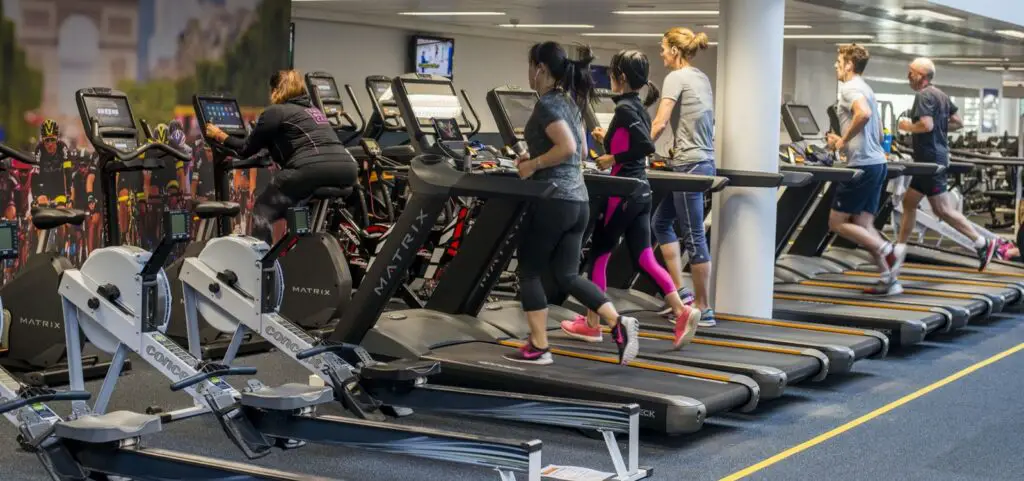Introduction
What Times Are Gyms Most Busy: Navigating the bustling world of fitness centers requires more than just knowing how to perform the perfect squat or execute a flawless plank. One key factor that significantly impacts your workout experience is understanding the ebb and flow of gym activity throughout the day. “What times are gyms most busy?” is a question that has echoed in the minds of many fitness enthusiasts, both seasoned and novice. Whether you’re aiming to avoid the crowds, relish in the energy of a full house, or simply plan your workouts strategically, delving into the patterns of gym attendance can be invaluable. From the early morning risers seeking a pre-workday pump to the evening warriors battling stress after hours, deciphering the peaks and valleys of total gym traffic involves unraveling a multifaceted web of individual preferences, societal norms, and biological rhythms. Join us as we explore the fascinating realm of gym activity trends and unveil the science and art behind selecting the optimal time to pursue your fitness goals.
In the modern pursuit of a healthier lifestyle, fitness centers have become sanctuaries for self-improvement, wellness, and transformation. Yet, within these temples of personal betterment, a dynamic dance of activity unfolds throughout the day, reflecting the diverse routines and lifestyles of the gym-goers themselves. The question of when gyms are most busy is not merely a matter of convenience; it’s an inquiry that touches on the psychology of motivation, the physiological rhythms of the human body, and the societal rhythms that shape our daily lives. From the crack of dawn, when the first rays of sunlight peek over the horizon, to the late hours of the evening when the city lights twinkle in the distance, gym attendance experiences a constant ebb and flow. The early birds seize the morning hours, harnessing the invigorating power of exercise to kickstart their day.
The lunchtime rush is a phenomenon of its own, with office workers and students striving for a refreshing break amidst their daily tasks. Yet, perhaps the most recognizable crescendo in gym activity arrives in the late afternoon and early evening, when the after-work exodus flocks to the gym floors. Here, a fusion of motivation and release intertwines, as individuals strive to shed the stresses of the day and harness the energy amassed throughout their work hours. Conversations blend with clinking weights, and the hum of treadmills creates a symphony of determination. Behind these waves of gym attendance lie deeper psychological motives. The early mornings appeal to those who value discipline and the sense of accomplishment that comes with conquering a workout before sunrise. The after-work rush caters to individuals seeking camaraderie, motivation, and a physical outlet for the tensions of their professional lives. Beyond personal preference, societal norms influence these patterns too, with culture and location shaping when we prioritize fitness.

What time of day are gyms least busy?
But if we eliminate those hours from the equation, as with non-24-hour gyms, that survey combined with The Barbell’s own survey using Google Maps “Popular Times” data reveal that the early afternoon: 12 PM to 3 PM and late evening: after 8 PM are the least crowded for most commercial gyms.
For those willing to rise with the sun, early mornings often present the least crowded gym environment. The hours just before sunrise to mid-morning are typically characterized by a tranquil ambiance. Early risers often have the luxury of having the gym to themselves or sharing it with only a handful of fellow enthusiasts. This time slot appeals to individuals who prioritize solitude, focus, and the satisfaction of conquering a workout before the day unfolds.
The mid-morning to lunchtime hours offer another opportunity for a less crowded gym experience. After the initial early morning rush subsides, there’s a brief window before the lunchtime crowd arrives. During this time, you can often find a peaceful setting where you can engage in your workouts without the need to wait for equipment or compete for space.
The hours following the lunchtime rush and before the post-work surge usually experience a lull in gym activity. Early afternoons, particularly from around 1:00 PM to 4:00 PM, can provide a chance to capitalize on lower traffic. People are typically occupied with work or other commitments during this time, making it a potential sweet spot for those seeking a less hectic gym environment.
What is the best time to go to the gym at?
Between 2 p.m. and 6 p.m., your body temperature is at its highest. This may mean you’ll be exercising during the window of time your body is most ready, potentially making it the most effective time of day to work out.
Starting your day with a workout can set a positive tone for the rest of the day. The early morning hours, just before sunrise to mid-morning, are known for their serene atmosphere and lower gym traffic. Engaging in exercise during this time can help boost your metabolism, increase energy levels, and create a sense of accomplishment before tackling the demands of the day.
If you’re not an early riser, the afternoon hours might be more suitable for you. After a morning of work or other commitments, hitting the gym during lunchtime or early afternoon can provide a refreshing break. This midday workout can revitalize your energy levels, clear your mind, and help you stay focused for the remainder of the day.
For many individuals, the late afternoon and early evening hours are the sweet spot for workouts. This period often witnesses the highest gym attendance, creating an energetic atmosphere that can be motivating. If you thrive on the buzz of a crowded gym and enjoy the camaraderie of fellow fitness enthusiasts, this might be the ideal time for you.
Is the gym busy at 5 am?
According to Fitbit data, gyms are less busy between 5-6 and 7-8 a.m. Once you fit in that morning workout, you’ll feel accomplished and ready to tackle the day. You won’t have a workout hanging over your head or have to wonder how to find time to work out — or have it kicked to the curb when something pops up.
At 5 am, most of the world is still cocooned in slumber, and the streets are devoid of traffic. This tranquility extends to the gym as well. The early morning hours typically witness a slower pace of activity, translating to shorter wait times for equipment and less competition for space. For individuals who cherish solitude and the freedom to focus entirely on their workout routine, this window of quiet can be a priceless asset.
Embarking on a workout regimen at 5 am requires a strong dose of discipline. For those who succeed, this consistency can be a game-changer. By making exercise a part of their early morning routine, individuals can establish a consistent pattern that helps kickstart their metabolism, boost energy levels, and set a productive tone for the day ahead.
The 5 am gym session can be a savior for those with demanding schedules. Whether you’re a busy professional, a parent juggling family responsibilities, or someone simply seeking a productive start, the early morning offers an opportunity to carve out time for self-improvement before external obligations take center stage.
While the gym might be less crowded at 5 am, it doesn’t mean you’re alone. Early risers who prioritize fitness often share a camaraderie borne from their dedication. Engaging with like-minded individuals during this time can foster a sense of community and motivation that’s unique to the early morning crowd.
Are gyms crowded at 4pm?
Most gyms are packed in the early morning because for most people, it’s the only way to fit a workout into their daily work schedule. The typical commercial gym will likely see a second (though smaller) rush around lunch hour, and most gyms are typically the busiest between 4 PM and 7 PM.
4 pm marks the juncture where daytime commitments often give way to personal pursuits. It’s a time when students emerge from classrooms and professionals start winding down their workday. Consequently, many gyms experience an uptick in activity during this window. The post-school crowd, including teenagers and parents, flocks to the gym to channel their energy and achieve their fitness goals.
Simultaneously, the after-work exodus commences as individuals seek solace in the gym after a day spent in offices and meetings. The 4 pm to 6 pm time frame witnesses a flurry of activity as people strive to release accumulated stress, increase their heart rates, and interact with like-minded individuals. This period often boasts high gym attendance, transforming fitness centers into bustling hubs of energy and determination.
The heightened gym traffic at 4 pm might entail some navigational challenges. Popular equipment might be occupied, and certain areas could experience congestion. However, the abundance of individuals engaged in their workouts creates an atmosphere of camaraderie and mutual motivation, inspiring gym-goers to push their limits.
Is 2pm good for the gym?
Body temperature keeps rising throughout the day, typically reaching its peak between 2pm and 6pm. This is when your body is primed for exercise as muscle function, strength, and endurance are optimum. In the late afternoon, heart rate and blood pressure dip to their lowest, thus decreasing risks of injury.
Around 2 pm, many individuals have completed their midday meals and are seeking a surge of energy to power through the remainder of the day. This makes it an opportune time for a gym session. A well-timed workout can provide a natural energy boost, helping to stave off the post-lunch slump and reinvigorating your focus and productivity.
One of the primary advantages of hitting the gym at 2 pm is the potential to avoid the bustling crowds associated with the early morning and post-work hours. This means shorter wait times for equipment, more available space, and a quieter environment that allows you to concentrate on your workout routines.
For individuals with flexible schedules, 2 pm offers a convenient option. It’s a time slot that can accommodate both early risers and those who prefer to ease into their mornings. If your daily routine allows for a mid-afternoon break, heading to the gym at 2 pm can be an excellent way to break up the day and engage in a focused workout.
Is it okay to go to the gym at 7 pm?
Robbins said, “I think the optimal time for exercise, just to reap the benefits of those endorphins releasing, would probably be in the early afternoon.” And, if you notice that working out later in the day keeps you from falling asleep, she said, you might want to consider hitting the gym between 4 and 7 p.m. so you.
At 7 pm, the gym transforms into a haven of release for many individuals seeking to unwind after a day of responsibilities. Engaging in a workout during this time can serve as a powerful mental and physical reset, allowing you to shed the stresses of the day and channel your energy into something productive.
For those with busy work schedules, 7 pm can be a convenient time to visit the gym. By this hour, most offices have closed their doors, freeing up time for you to focus on your well-being. This post-work window allows you to immerse yourself in a workout without the looming pressure of work-related tasks.
The 7 pm gym slot often experiences a dip in attendance compared to the after-work rush, making it an excellent option for those who prefer a quieter environment. The reduced crowd translates to shorter wait times for equipment, more space to move freely, and a serene atmosphere that can enhance your workout experience.
Should I go to the gym at 7 pm?
But there’s a common belief that evening exercise perks you up so much that it’s difficult to fall asleep later. While the Journal of Physiology study found that exercising between 7 p.m. and 10 p.m. delays the body clock, translating to later bedtimes, Hackney says he’s not convinced that’s the case.
Advantages of Going to the Gym at 7 pm
Unwinding After the Day: Engaging in a workout at 7 pm can offer a powerful way to unwind after a long day of work or responsibilities. Physical activity can serve as a stress-reliever, helping you release tension and rejuvenate your mind.
Freer Schedule: By 7 pm, most people have completed their work or other obligations, creating a window of opportunity for you to prioritize your fitness without the pressure of time constraints.
Avoiding Rush Hour: Many gyms experience peak attendance during the early morning and after-work hours. By opting for a 7 pm gym session, you can often avoid the bustling crowds and enjoy a quieter and more focused workout environment.
Do introverts go to gym?
It’s easy to imagine everyone is watching and judging you when you walk into the gym. The reality is that at least half the people in the gym are also introverts, and the remainder are likely more focused on their own workouts and appearance to notice what you’re doing.
Self-Paced Workouts: At the gym, individuals can choose their own exercises, sets, and intensity levels, giving introverts control over their workouts. They can design routines that match their fitness goals and preferences without external pressure.
Solitary Options: While many people enjoy the social aspects of the gym, introverts can find solace in solitary activities like running on a treadmill, using weight machines, or practicing yoga in a corner studio. Gyms often offer a range of options to accommodate different workout styles.
Non-Verbal Communication: For introverts, non-verbal communication can be just as meaningful as verbal interaction. In the gym, nods of encouragement, smiles, or simply working alongside others can create a sense of camaraderie without the need for extensive conversation.

Conclusion
In the realm of fitness, the quest for a healthier lifestyle is as diverse as the people who embark on it. From the predawn dedication of early risers to the post-workday camaraderie of evening enthusiasts, the ebb and flow of gym activity paints a canvas of human endeavor, determination, and transformation. Understanding the nuances of gym attendance isn’t solely about avoiding crowds or securing the perfect workout slot; it’s about aligning our fitness journey with our individual preferences and goals. The early morning sessions offer solitude and discipline, while the after-work hustle delivers a sense of community and catharsis. The symphony of gym activity is a reflection of our innate desire for self-improvement, mental release, and a healthier life. As we contemplate the rhythms of gyms busy attendance, we recognize that this phenomenon transcends the walls of fitness centers. It mirrors our pursuit of balance, our ability to adapt to life’s demands, and our relentless aspiration for well-being. The question of when gyms are most busy transforms into a profound exploration of our own motivations, a reminder that we are not just seeking physical change, but also personal growth.
So, whether you find solace in the quiet dawn, camaraderie in the evening buzz, or empowerment in defying the norm, the gym’s pulse is a reminder that the journey is yours to shape. Beyond the superficial consideration of when to avoid the crowds, this inquiry delves into the deeper realms of motivation, discipline, and the quest for self-improvement. In the early hours, the rhythmic clank of weights and the whirring of machines bear witness to the dedication of those who rise before the sun. These early birds harness the quietude of the dawn to sculpt their bodies and fortify their minds, setting an inspirational tone for the day ahead. The mid-morning and lunchtime waves signify the convergence of fitness and daily routine, where wellness seamlessly merges with the demands of life.
Yet, it is the evening crescendo that often captures our attention—the hours when work attire transforms into workout gear and the gym becomes a sanctuary of sweat and rejuvenation. The flurry of activity reflects not just a physical exertion, but an emotional release—a shedding of the day’s burdens in exchange for the energy of a challenging workout and the camaraderie of fellow warriors. As the sun dips below the horizon, the gym’s symphony quiets, but the echoes remain. The question of gym activity’s peak times speaks to the essence of our human nature: our constant pursuit of betterment, our response to societal rhythms, and our individual strategies for navigating a world bustling with demands. This inquiry serves as a metaphor for the choices we make in life—whether to embrace solitude, seek companionship, or simply defy convention.

